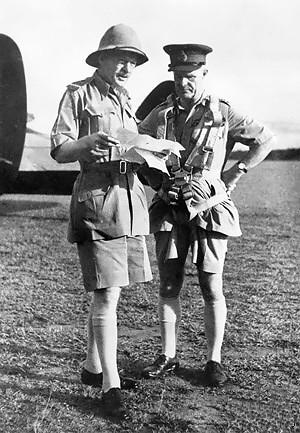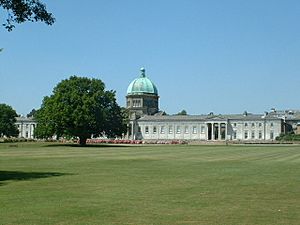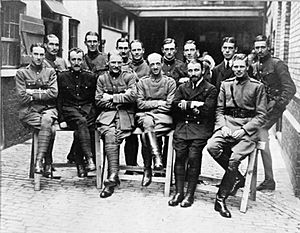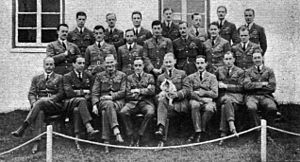Robert Brooke-Popham facts for kids
Quick facts for kids
Sir Robert Brooke-Popham
|
|
|---|---|

Brooke-Popham (left) with General Wavell
|
|
| Nickname(s) | Brookham |
| Born | 18 September 1878 Mendlesham, Suffolk |
| Died | 20 October 1953 (aged 75) RAF Halton, Buckinghamshire |
| Allegiance | United Kingdom |
| Service/ |
British Army (1898–1918) Royal Air Force (1918–1942) |
| Years of service | c. 1898–1937 1939–1942 |
| Rank | Air chief marshal |
| Commands held | Far East Command (1940–41) Inspector-General of the RAF (1935) Air Defence of Great Britain (1933–35) Imperial Defence College (1931–33) Iraq Command (1928–30) RAF Staff College, Andover (1922–26) No. 3 Wing RFC (1914–15) No. 3 Squadron RFC (1912–14) |
| Battles/wars | Second Boer War First World War Second World War |
| Awards | Knight Grand Cross of the Royal Victorian Order Knight Commander of the Order of the Bath Companion of the Order of St Michael and St George Distinguished Service Order Air Force Cross Mentioned in Despatches (4) Officer of the Legion of Honour (France) Order of Saint Stanislaus, 2nd Class (Russia) |
Air Chief Marshal Sir Henry Robert Moore Brooke-Popham, GCVO, KCB, CMG, DSO, AFC (born September 18, 1878 – died October 20, 1953) was an important leader in the Royal Air Force (RAF). He was often called "Brookham." During the First World War, he flew with the Royal Flying Corps. After the war, he helped create the RAF's first training college. He also served as the Governor of Kenya. Later, during the Second World War, he was in charge of British forces in the Far East, including Singapore and Malaya, before these areas were taken by Japanese troops.
Contents
Early Life and Education
Henry Robert Moore Brooke-Popham was born in Mendlesham, Suffolk, England, on September 18, 1878. His father, Henry Brooke, was a country gentleman. His mother, Dulcibella, was the daughter of a clergyman.
Brooke-Popham attended South Lodge School from 1885 to 1891. He then went to Haileybury. After that, he trained to be an officer at the Royal Military College, Sandhurst. He joined the British Army in 1898. In 1926, he married Opal Mary. They had a son and a daughter.
Joining the Military
After finishing at Sandhurst in May 1898, Brooke-Popham became a second lieutenant in the Oxfordshire Light Infantry. He was promoted to lieutenant in November 1899. He fought in the Second Boer War in South Africa from 1899 to 1900. He served in different areas like the Orange Free State and the Transvaal Colony. In 1904, he became a captain. By 1910, he was back in Great Britain. He then attended the Army Staff College to learn more about military leadership.
Learning to Fly Before World War I
Brooke-Popham became interested in flying in 1911. He learned to fly at a school in Brooklands. He earned his pilot's certificate in July 1911. In 1912, he joined the Air Battalion, which was a group of military pilots. He quickly became the leader of the Battalion's Aeroplane Company.
In May 1912, the Royal Flying Corps (RFC) was created from the Air Battalion. Brooke-Popham joined the RFC and became the first leader of No. 3 Squadron. This squadron was the oldest British military unit to use airplanes.
Service in the First World War
When the First World War started, Brooke-Popham went to France. He worked at the RFC headquarters, making sure squadrons had the support they needed. He believed that air power was very important for helping ground forces.
In November 1914, Brooke-Popham became the leader of No. 3 Wing of the RFC. This group included two squadrons. He was temporarily promoted to lieutenant colonel. During the Battle of Neuve Chapelle, he led his Wing's operations. He received the Distinguished Service Order for his actions in the battle.
By 1915, Brooke-Popham was a high-ranking officer. He spent most of his time on planning and organizing, rather than flying in combat. He held several important staff jobs at the RFC headquarters in France. He became the RFC's Chief Staff Officer in May 1915. In March 1916, he was promoted to brigadier-general.
During the war, communication between pilots and ground troops was hard. In 1915, a new way to send messages was created. Troops on the ground would lay out white cloth strips. These strips, called "Popham strips," helped pilots understand messages from below.
In April 1918, the Royal Air Force (RAF) was formed. Brooke-Popham moved to the new Air Ministry in London. He was in charge of aircraft production for the rest of the war. In 1919, he became the Director of Aircraft Research. The "Popham panel," a tool developed during the war, was named after him.
RAF Service Between the World Wars
After the First World War, Brooke-Popham received many awards for his service. He was given the Air Force Cross and became a Companion of the Order of St Michael and St George. He also became a Companion of the Order of the Bath. He was given a permanent role in the Royal Air Force as a colonel. In August 1919, he was quickly promoted to air commodore when the RAF created its own rank system.
Leading the RAF Staff College
From 1919 to 1921, Brooke-Popham worked as the Director of Research at the Air Ministry. In November 1921, he was given the job of setting up the RAF Staff College at Andover. He became its first leader on April 1, 1922.
In 1925, the Air Defence of Great Britain was created to protect the United Kingdom from air attacks. Brooke-Popham became the Air Officer Commanding (AOC) of the Fighting Area within this defense group. He oversaw the building of large concrete mirrors. These mirrors were designed to listen for enemy aircraft from far away. He was knighted in 1927.
Commanding in Iraq and Beyond
In November 1928, Brooke-Popham was put in charge of the RAF Iraq Command. This was a very important job, as he led all British forces in Iraq. He even acted as the high commissioner when that position was empty. In late 1928, he helped rescue British embassy staff and others in Kabul by air.
In 1931, Brooke-Popham was promoted to air marshal. He became the first RAF officer to lead the Imperial Defence College. Two years later, in 1933, he returned to the Air Defence of Great Britain as its top commander. He also became a special aide to the King. In 1935, he became the Inspector-General of the RAF, but this was a short role.
Leading in the Middle East
In late 1935, Brooke-Popham took command of the RAF Middle East in Cairo. This was soon after the Second Italo-Abyssinian War began. His main goal was to stop the Italian air force from attacking British areas in North East Africa. In 1937, he left this command and retired from the RAF.
Governor of Kenya
After Italy took over Ethiopia, the British government wanted a military person to be the Governor of Kenya. Brooke-Popham was appointed Governor and Commander-in-Chief of Kenya in 1937. His military skills helped the colony get ready for a possible war with Italy. He planned to focus defenses on the important port of Mombasa. This port was thought to be the most likely target for an Italian attack.
Brooke-Popham also worked to improve relations with the settlers in Kenya. However, some people have said he did not do enough to protect the freedoms of African and Asian people there.
When the Second World War started in 1939, Brooke-Popham ordered that all Germans in Kenya be held. He also made sure that all aircraft were taken for military use. He created a plan to keep the colony's farms working. He left his role as governor in September 1939 and returned to Britain.
Second World War Service
Air Training Plans
Brooke-Popham rejoined the RAF shortly after the Second World War began. He first led the RAF's training mission to Canada. There, he helped set up the British Commonwealth Air Training Plan. In 1940, he went to South Africa to continue this important training work.
Commander in the Far East
On November 18, 1940, at 62 years old, Brooke-Popham was put in charge of the British Far East Command. This meant he was responsible for defending Singapore, Malaya, Burma, and Hong Kong. This was a very challenging job. It was a new command, and Brooke-Popham was the first RAF officer to lead such a combined force during a world war.
There were some difficulties because the navy units in the area did not report to him. They reported directly to London. Also, local government officials did not report to him either.
Building Defenses
With the Japanese threatening South-East Asia, Brooke-Popham knew he needed to strengthen the defenses. The existing defenses were mostly for attacks from the sea. There were not enough forces everywhere. Air defenses were especially weak. Many British resources were being sent to the Middle East instead. For a year, Brooke-Popham tried to build up defenses and get more troops, but it was very difficult.
Operation Matador
In August 1941, Brooke-Popham sent a defense plan for Malaya to London. This plan, called Matador, assumed the Japanese would land on the east coast of Thailand and move south. The plan involved Allied forces moving into Thailand to fight the Japanese there. However, Brooke-Popham did not have enough forces for this plan. It also meant breaking Thailand's neutrality.
On November 22, the Japanese were setting up bases in southern Indo-China. Brooke-Popham urged London to let him start Operation Matador. He finally got permission on December 5, but with many conditions. The plan was changed because of the limited forces. On December 8, the war with Japan began. Two days before the Malayan Campaign started, British planes spotted the Japanese invasion fleet. But because of unclear instructions, Brooke-Popham did not allow the convoy to be bombed.
London had decided that Brooke-Popham should be replaced on November 1, 1941, but the change was delayed due to the serious situation. As the war with Japan unfolded, many felt Brooke-Popham was struggling under the pressure. On December 27, during the Battle of Malaya, Brooke-Popham handed over command to Lieutenant-General Sir Henry Pownall. Soon after he returned to Britain, Singapore fell on February 15, 1942. Many people blamed Brooke-Popham for this defeat.
Later War Years and Retirement
In May 1942, Brooke-Popham retired from the RAF for the second time. Even though his reputation was hurt by the events in the Far East, he continued to serve. From 1942 to 1945, he was the Inspector-General of the Air Training Corps. From 1944 to 1946, he was the President of the Navy, Army and Air Force Institutes Council.
After these roles, he lived in retirement. Brooke-Popham passed away in a hospital at RAF Halton in Buckinghamshire on October 20, 1953. He was buried privately in Somerset.
|





